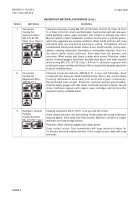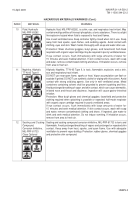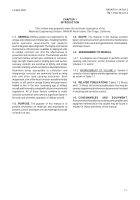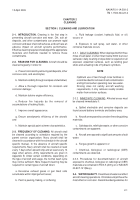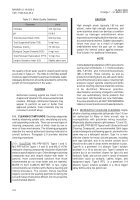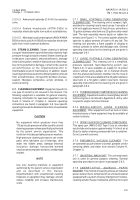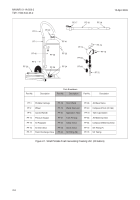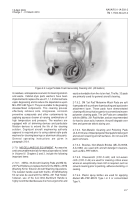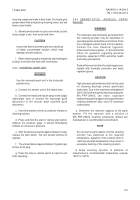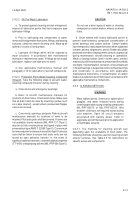TM-1-1500-344-23-2 - Page 28 of 240
2-4
NAVAIR 01-1A-509-2
TM 1-1500-344-23-2
15 April 2009
NOTE
The use of solvents for cleaning operations is
dependent upon stringent environmental and
safety regulations. Determine local
requirements regarding limitations and
restrictions on materials, quantities, and
disposal from your work center supervisor,
safety officer, or industrial hygienist.
Degreasing Solvent, MIL-PRF-680, replaces
Dry Cleaning and Degreasing Solvent, P-D-680.
MIL-PRF-680 has been reformulated to
eliminate Hazardous Air Pollutants, however,
its high VOC content may prevent use in some
locations.
2-5.7.1. Degreasing Solvent (MIL-PRF-680). This
solvent is used as a cleaner and degreaser for painted
and unpainted metal parts. It is also used to remove oily
corrosion preventive compounds. The solvent is
available in four types. Although the degreasing
effectiveness is approximately the same for each type,
the flash points as a measure of flammability differ as
follows: Type I, 100
°
F (38
°
C) minimum; Type II, 140
°
F
(61
°
C) minimum; Type III, 200
°
F (93
°
C) minimum;
Type IV, 140
°
F (61
°
C) minimum. A lower flash point
indicates greater flammability; however, all types will
burn intensely once ignited. Type I is not authorized for
use as a general cleaner due to its flammability, but may
be used in parts washers that are designed for such
solvents. Type II is the most common cleaning solvent
used on aircraft, and is intended for use where a solvent
with a higher flash point is required. Type III is intended
for use in confined atmospheric conditions where a very
high flash point is required. Type IV is used where a
higher flash point and strong solvency is desired. The
dwell time for all types should be held to a minimum
(less than 15 minutes) to avoid damage to paint.
2-5.7.2. Isopropyl Alcohol (TT-I-735). This flammable
solvent is used as a disinfectant, and for removing
fungus and mold from aircraft surfaces. It is a poor
degreaser, but is a good solvent for removing fingerprints.
2-5.7.3. Methyl Ethyl Ketone (MEK) (ASTM D 740).
This highly flammable solvent is used for cleaning prior
to adhesive bonding. Most locations cannot use MEK as
a wipe solvent for general cleaning or prior to painting
due to restrictions on the use of solvents with vapor
pressures greater than 45 millimeters of mercury (mm
Hg). As an alternate cleaner, use MIL-PRF-85570 Type II
Aircraft Cleaning Compound (diluted 1 part cleaner to
14 parts water), rinse thoroughly with fresh water and
allow surfaces to dry. Surfaces may be also be cleaned
by solvent wiping with AMS 3166 (Solvents, Cleaning
Prior to Application of Sealing Compounds).
2-5.7.4. Aliphatic Naphtha (TT-N-95). This highly
flammable solvent is used for cleaning oils or greasy
deposits and other soils from aircraft transparencies
such as acrylic canopy materials. Other solvents may
cause crazing and other damage to transparencies. It is
also effective at removing masking or preservation tape
residue. This material may be restricted in many
geographic locations for other cleaning operations due
to its high vapor pressure.
2-5.7.5. Thinner, Aliphatic Polyurethane Coatings
(MlL-T-81772). This highly flammable solvent can be
used for prepaint solvent cleaning as an alternative to
MEK. MIL-T-81772 may be used at locations requiring
a solvent vapor pressure less than or equal to 45 mm Hg.
2-5.8. PARTS WASHER CLEANING SOLUTION.
MIL-PRF-29602 (Cleaning Compounds for Parts Washer
and Spray Cabinets) is the recommended cleaning
agent for use in high pressure cabinet-style parts washers
to remove oils and greases from disassembled
components. It shall not be used for bearings unless
authorized by part specific documentation. Also, due to
the high maximum allowable pH (pH 13.5) of
MIL-PRF-29602 cleaning compound, aircraft cognizant
engineering authority approval is required before
cleaning aluminum alloy parts. MIL-PRF-29602 must
be diluted with water in accordance with manufacturer’s
instructions, and the concentration must be tested
periodically (every 28 days is recommended).
2-5.9. MILDEW REMOVER. NAVCLEAN is a mildew
remover developed by NAVAIR for cleaning mildew,
mold, and fungus from aircraft surfaces. The mildew
remover kit consists of four components (an oxidizing
agent, a detergent, and corrosion inhibitors). The
components are mixed with water immediately prior to
use. The solution is effective for twenty four hours after
mixing. Surfaces cleaned with NAVCLEAN shall be
rinsed thoroughly with fresh water after application to
remove residue.
2-5.10. MISCELLANEOUS CLEANING AGENTS.
2-5.10.1. Plastic polish (P-P-560), which contains mild
abrasives, to polish out scratches in certain canopy
materials.
2-5.10.2. Optical glass cleaner (A-A-59199) for cleaning
lenses.
Change 1 - 31 March 2010
Back to Top

